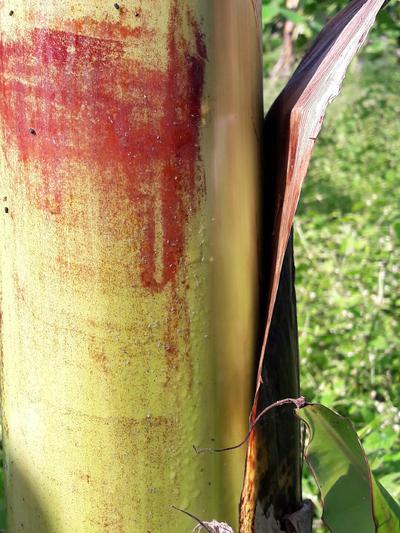Banana Bract Mosaic Virus
BBrMV
Virus
In a Nutshell
- Blemishes, streaks and spindle shaped discolorations in pseudostems. Mosaic patterns are obvious at flowering.
- Leaf veins may also become prominent.
Can also be found in
Symptoms
The most obvious symptom appears on the bracts of the inflorescence as a reddish-brown mosaic pattern. Bracts are the name for the small leaves that cover the rows of flowers on the flower stalk. In young plants, chlorotic or red-brown spindle-shaped lesions and streaks can be found on leaf petioles or midribs. Occasionally, they also appear on the blade running parallel to the veins or on the stem of fruit bunches. When the dead leaves are pulled off, dark brown blemishes or streaks are visible on the internal tissue. Growth defects on bunches and deformed fruits are also characteristic of the disease. The virus can spread quickly and severe infection can lead to losses in fruit yield and quality.
Recommendations

Organic Control
The bio-control fungal agent verticillium lecanii can be used to reduce populations of aphids. Insecticidal soap can also be used to control aphids when their numbers are not too high.

Chemical Control
Always consider an integrated approach with preventive measures together with biological treatments if available. There is in no direct chemical treatment of viral diseases. However, the use of pesticides can control aphid populations up to a certain degree (for example cypermethrin, acetamid, chlorpyrifos) Herbicides can be used to kill affected plants or young shoots growing from severed trees.
What caused it?
The symptoms are caused by a virus that affects banana trees at different growth stages. It is transmitted in a non-persistent manner by several species of aphids. The virus, acquired while feeding on infected plants, only survives for a short period in the vector. The transfer or transport of infected plant material between fields is another way of transmission. Its common name comes from the characteristic mosaic symptoms on the flower bracts.
Preventive Measures
- Use seeds or seedlings from certified disease-free sources.
- Monitor the crop regularly for signs of disease.
- Clean tools and equipments when working in different fields.
- Pick up and destroy plants with suspect symptoms.



